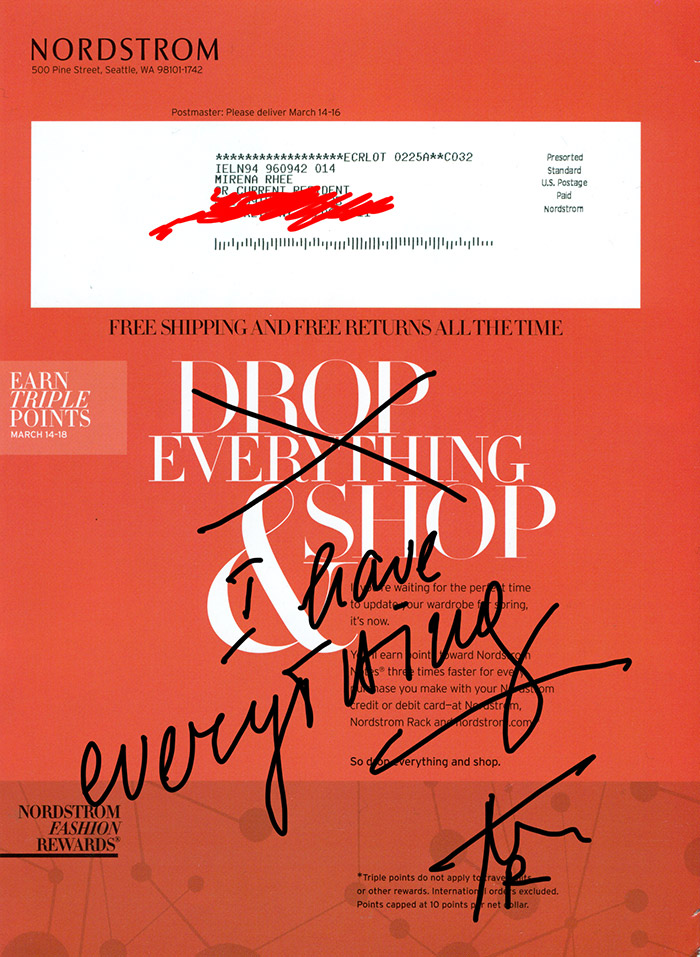Illustrated by Shea Strauss.






Uncategorized on Purpose
Day 4000 of Mars rover Opportunity's 90 day mission /
As I sit here on my little desk in front of my little computer, the last thing I'd like to lose is the ability to be astounded. It is important to get groceries and to plan the next big drawing, taxes are also pretty valid concern. But what will get us out of the pit of ignorance and every-day obtuseness is our continuing ability to be astounded. It is pretty astonishing the Mars rover Opportunity has been on Mars 45 times its intended lifespan. And, thank God, there are these crazy people that continue to run it. The rover was designed, built, and operated by JPL, which is managed by Caltech.
NASA"s Opportunity tracks on Mars:
Here is Opportunity's detailed traverse map on Mars:
The entirety of Opportunity's decade of driving on Mars:
Leonardo da Vinci's Codex on Bird Flight is also on Mars.
For all those who submitted your names, Congratulations! Your name was successfully etched onto a microchip and is officially on Mars!
And here is how it all happened - http://mars.jpl.nasa.gov/msl/participate/sendyourname/
And, finally, the ability to be astounded as borrowed from a 3 years old:
Timeline of Ancient Philosophers /
The Smartest Book About Our Digital Age Was Published in 1929 /
One of the best media articles of 2014 which I found on an old internet haunt - digg. It has always been the case that we sooner or later discover that everything has already been thought of, or painted, or expressed. We get on our phones, the signal goes out to space and back to tells us that Plato is still pretty much interesting. When googling the Chauvet Cave I can't help but think about Picasso and the studies he did for Guernica. Rest assured, nothing profoundly changed in 2014,
and
Happy Holidays.
Below is the article as it appeared in the The Daily Beast.
How José Ortega y Gasset's The Revolt of the Masses helps us understand everything from YouTube to Duck Dynasty.
I first read José Ortega y Gasset’s The Revolt of the Masses more than thirty years ago. I still remember how disappointed I was by this cantankerous book. I’d read other works by Ortega (1883-1955), and been impressed by the Spanish philosopher’s intelligence and insight. But this 1929 study of the modern world, his most famous book, struck me as hopelessly nostalgic and elitist.
Yet I recently read The Revolt of the Masses again, and with a completely different response. The same ideas I dismissed as old-fashioned and out-of-date back in the 20th century now reveal an uncanny ability to explain the most peculiar happenings of the digital age.
Are you, like me, puzzled to learn that Popular Science magazine recently shut down comments on its website, declaring that they were bad for science? Are you amazed, like me, that Duck Dynasty is the most-watched nonfiction cable show in TV history? Are you dismayed, like me, that crappy Hollywood films about comic book heroes and defunct TV shows have taken over every movie theater? Are you depressed, like me, that symphony orchestras are declaring bankruptcy, but Justin Bieber earned $58 million last year?
If so, you need to read The Revolt of the Masses. You’ve got questions. Ortega’s got answers.
First, let me tell you what you won’t find in this book. Despite a title that promises political analysis, The Revolt of the Masses has almost nothing to say about conventional party ideologies and alignments. Ortega shows little interest in fascism or capitalism or Marxism, and this troubled me when I first read the book. (Although, in retrospect, the philosopher’s passing comments on these matters proved remarkably prescient—for example his smug dismissal of Russian communism as destined to failure in the West, and his prediction of the rise of a European union.) Above all, he hardly acknowledges the existence of ‘left’ and ‘right’ in political debates.
Ortega’s brilliant insight came in understanding that the battle between ‘up’ and ‘down’ could be as important in spurring social and cultural change as the conflict between ‘left’ and ‘right’. This is not an economic distinction in Ortega’s mind. The new conflict, he insists, is not between “hierarchically superior and inferior classes…. upper classes or lower classes.” A millionaire could be a member of the masses, according to Ortega’s surprising schema. And a pauper might represent the elite.
The key driver of change, as Ortega sees it, comes from a shocking attitude characteristic of the modern age—or, at least, Ortega was shocked. Put simply, the masses hate experts. If forced to choose between the advice of the learned and the vague impressions of other people just like themselves, the masses invariably turn to the latter. The upper elite still try to pronounce judgments and lead, but fewer and fewer of those down below pay attention.
He understands that the rise of new technological tools gives a global scope to the unformed opinions of people who, in a previous era, would have only focused on what was nearby and familiar. Above all, the favorite source of wisdom for the masses, in Ortega’s schema, is their own strident opinions. “Why should he listen, when he has all the answers, everything he needs to know?” Ortega writes. “It is no longer the season to listen, but on the contrary, a time to pass judgment, to pronounce sentence, to issue proclamations.”
Ortega couldn’t have foreseen digital age culture, but he is describing it with precision. He would recognize the angry, assertive tone of comments on web articles as the exact same tendency he identified in 1929. He would understand why Yelp reviews have more influence than the considered judgments of restaurant reviewers. He would know why Amazon customer comments have more clout than critics in The New Yorker. He would attend an angry town hall meeting or listen to talk radio, and recognize the same tendencies he described in his book.
Recently I had dinner with a friend who is affluent, educated, and a noted wine connoisseur. We were talking about wine critic Robert Parker and other experts, and my friend asserted that he now relies more on wine advice from websites where anyone can post their evaluations of different vintages. And if the mass mentality has taken over wine-tasting, what can we expect from film reviews or rock criticism?
Of course, this rise of mass opinion comes at a cost. For example, music criticism is turning into lifestyle reporting. Even specialist magazines avoid dealing with any technical descriptions of what a performer is doing, and I have a hunch that the less critics know about the structure of music, the more likely they are to succeed today. This same tendency, outlined with precision by Ortega back in 1929, can be seen in numerous other fields where experts once reigned, but have now been replaced by the opinions of the masses.
Strange to say, not all kinds of expertise are ignored nowadays. The same people who denounce expert opinion about movies or music will praise a skilled plumber or car mechanic. The value of blue-collar expertise is accepted without question. The same people who get angry when I make judgments about the skill level of a pianist, would never question my decision to pay more to hire a superior piano tuner. This is a peculiar state of affairs, but very much aligned with the “revolt of the masses.”
Ortega also predicted the close connection between advancing technologies and these new rude attitudes. He devotes an entire chapter to the co-existence of “primitivism and technology.” He understands that the rise of new technological tools gives a global scope to the unformed opinions of people who, in a previous era, would have only focused on what was nearby and familiar. Above all, he marvels at the fact that the “disdain for science as such is displayed with greatest impunity by the technicians themselves.” Or put differently, skill in manipulating a technology (say, Instagram or the iPhone, in our day) has nothing in common with a zeal for facts and empirical evidence. That shocked Ortega, but we encounter it daily on in the web.
I wish Ortega were around nowadays to comment on digital age culture. At one point in The Revolt of the Masses, he complains about a woman who told him “I can’t stand a dance to which less than 800 people have been invited.” So how would the Spanish philosopher respond to the crowd mentality that seeks out viral videos with a hundred million views? How would he evaluate TV reality shows in which the best singers or dancers are determined by the verdict of the masses? What would he think of political judgments shared by the millions in the form of 140-or-fewer-characters tweets?
I can’t do justice to all of this book’s riches in a short article. On almost every page, Ortega addresses some issue that still resonates today—for example, the rise of consumerism; or the possibility for barbarism to flourish in tandem with technology; or the unbalanced specialization which favors science over the humanities; or (in his words) “the loss of prestige of legislative assemblies.” You recognize all of those hot topics, don’t you?
Okay, we encounter these dysfunctional tendencies every day, but Ortega forces us to see them with a different perspective—from the standpoint of ‘up’ versus ‘down’. Indeed, his book is more valuable for the speculations it will spur in a current-day reader than in the specific situations Ortega addresses. But isn’t that always the measure of a timeless thinker?
Happy Thanksgiving /
Wish everyone a Very Happy Thanksgiving. Europe is cold and feels even colder after I spent considerable amount of time in Florida and California over the last couple of years. But as in New York, cold always stimulates the mind as there is no urge to be outside and move about.
Here are two pieces I did over Thanksgiving three years ago. For the first one I used the back of a Nordstrom catalog I got in the mail:
Another piece with a Thanksgiving theme is called I have everything. It is a digital collage over a photograph of me wearing a paper dress .The other strong theme here is Occupy and the effect the movement had on me and the way I viewed New York city. I have everything was completed shortly after NYPD cleared Zuccotti Park.
The paper dress I am wearing is a 30 x 40 inches mixed media piece. I painted over a Giclee print of my Lucasfilm W2 and scraps of paper collage:
You can listen to the voice piece about I have everything here:
45 Everyday Phrases Coined By Shakespeare /
Isn't language astonishing? The ability to convey complex concepts to another by means of few oddly shaped symbols. And then gurgling these out to make a point across the air, or scribbling them down in a way so they carry meaning 500 years later. BBC America has a list of 45 everyday phrases coined by William Shakespeare. In this context the words sound more beautiful and poetic than when used casually. Here is the list - you would be surprised:
“All our yesterdays”— (Macbeth)
“As good luck would have it” — (The Merry Wives of Windsor)
“As merry as the day is long” — (Much Ado About Nothing / King John)
“Bated breath” — (The Merchant of Venice)
“Be-all and the end-all” — (Macbeth)
“Neither a borrower nor a lender be” — (Hamlet)
“Brave new world” — (The Tempest)
“Break the ice” — (The Taming of the Shrew)
“Brevity is the soul of wit” — (Hamlet)
“Refuse to budge an inch” — (Measure for Measure / The Taming of the Shrew)
“Cold comfort” — (The Taming of the Shrew / King John)
“Conscience does make cowards of us all” — (Hamlet)
“Crack of doom” — (Macbeth)
“Dead as a doornail” — (Henry VI Part II)
“A dish fit for the gods” — (Julius Caesar)
“Cry havoc and let slip the dogs of war” — (Julius Caesar)
“Devil incarnate” — (Titus Andronicus / Henry V)
“Eaten me out of house and home” — (Henry IV Part II)
“Faint hearted” — (Henry VI Part I)
“Fancy-free” — (A Midsummer Night’s Dream)
“Forever and a day” — (As You Like It)
“For goodness’ sake” — (Henry VIII)
“Foregone conclusion” — (Othello)
“Full circle” — (King Lear)
“The game is afoot” — (Henry IV Part I)
“Give the devil his due” — (Henry IV Part I)
“Good riddance” — (Troilus and Cressida)
“Jealousy is the green-eyed monster” — (Othello)
“Heart of gold” — (Henry V)
“Hoist with his own petard” — (Hamlet)
“Ill wind which blows no man to good” — (Henry IV Part II)
“In my heart of hearts” — (Hamlet)
“In my mind’s eye” — (Hamlet)
“Kill with kindness” — (The Taming of the Shrew)
“Knock knock! Who’s there?” — (Macbeth)
“Laughing stock” — (The Merry Wives of Windsor)
“Live long day” — (Julius Caesar)
“Love is blind” — (The Merchant of Venice)
“Milk of human kindness” — (Macbeth)
“More sinned against than sinning” — (King Lear)
“One fell swoop” — (Macbeth)
“Play fast and loose” — (King John)
“Set my teeth on edge” — (Henry IV Part I)
“Wear my heart upon my sleeve” — (Othello)
“Wild-goose chase” — (Romeo and Juliet)
The Song and the Body of a Comet /
As an artist I work with the body and my body of work is my voice. Native Americans always considered all inanimate objects to have inner lives and express their voices. Here is the voice of a Comet: You can find out more about how the song of this comet was captured on ESA's blog.
Below is the first ever close-up of the body of a comet ever captured. And the Welcome to a comet blogpost on ESA's site announcing the arrival of the images as we wait on more updates from the lander.
Isaac Asimov predicted the Internet of today 20 years ago /
Happy Halloween /
I have been a Star Wars fan since I was 7, I went to work for Lucasfilm as a 3d painter and sculptor and this was one of the best opportunities to grow and become an artist and a craftsman. George Lucas was not only a very generous employer but also created an environment where the artists had a great deal of ownership in the final product. Lucasfilm was created by an artist and was largely run by artists. I am sure once Disney took over this changed. George threw annual 4th of July and Halloween parties with costume contests that had no equal in the Silicon Valley. The most famous story was that one year ILM pushed the whole Pirates of the Caribbean ship, created as part of the movie set, into the party, complete with a pirate crew.
One year, a group of ILM's visual effects artists came up with the idea to dress up as Living Room Transformers - here is the couch ( with Jett Lucas in the background ):
I became a Naturalized US citizen 10 years ago today /
Isabey sent me a replacement brush - I am a fan for life /
 http://www.dickblick.com/products/isabey-pure-kolinsky-sable-brushes/
http://www.dickblick.com/products/isabey-pure-kolinsky-sable-brushes/
I get attached to the materials I work with - I have been a life-long computer geek, a brush geek, a linen geek, a paper geek. After all, for a time - you and the instrument in your hand become a one in the pursuit of a work of art, or simply of work. Knowing what we now know of the micro-world of particles, the simple act of commanding an object is a miracle.
Flexible Muscle-Based Locomotion for Bipedal Creatures /
Animation may soon become obsolete..:
"We present a muscle-based control method for simulated bipeds in which both the muscle routing and control parameters are optimized. This yields a generic locomotion control method that supports a variety of bipedal creatures. All actuation forces are the result of 3D simulated muscles, and a model of neural delay is included for all feedback paths. As a result, our controllers generate torque patterns that incorporate biomechanical constraints. The synthesized controllers find different gaits based on target speed, can cope with uneven terrain and external perturbations, and can steer to target directions."
Flexible Muscle-Based Locomotion for Bipedal Creatures from John Goatstream on Vimeo.
Merry Christmas from David Sedaris /
Matters of Scale /
The size of the Planck length can be visualized as follows: if a particle or dot about 0.1mm in size (which is at or near the smallest the unaided human eye can see) were magnified in size to be as large as the observable universe, then inside that universe-sized "dot", the Planck length would be roughly the size of an actual 0.1mm dot, that is, about the size of smallest object the naked human eye can see. In other words, the diameter of the observable universe is to within less than an order of magnitude, larger than a 0.1 millimeter object, roughly at or near the limits of the unaided human eye, by about the same factor (10^31) as that 0.1mm object or dot is larger than the Planck length. More simply - on a logarithmic scale, a dot is halfway between the Planck length and the size of the universe. Sorry for the plunder directly from wikipedia but it was too good to just link to.
Planck length Visualization:
"The size of the Planck length can be visualized as follows: if a particle or dot about 0.1mm in size (which is at or near the smallest the unaided human eye can see) were magnified in size to be as large as the observable universe, then inside that universe-sized "dot", the Planck length would be roughly the size of an actual 0.1mm dot, that is, about the size of smallest object the naked human eye can see. In other words, the diameter of the observable universe is to within less than an order of magnitude, larger than a 0.1 millimeter object, roughly at or near the limits of the unaided human eye, by about the same factor (10^31) as that 0.1mm object or dot is larger than the Planck length. More simply - on a logarithmic scale, a dot is halfway between the Planck length and the size of the universe."
My grandfather - circa 1938 /
My grandfather was an oil painter and a successful businessman, very skilled in the technique of Intarsia. He was very active in Bulgarian society prior to 1944 and was nominated, as part of a delegation of the Bulgarian trade elite, a godfather to King Simeon II of Bulgaria. He lost almost everything and escaped barely with his life during the communist revolution of 1944-47. He escaped execution with the help of a friendly lawyer but watched in terror from his house’s terrace high on the hills - the muzzle flashes of executions of many of his friends and colleagues. He was later sent to labor camps, was registered in the communist party’s archives as an enemy of the state and was not allowed to work for the rest of his life. Growing up I remember a very strange man living in my grandparents’ house - he was installed to spy on my grandparents' activities and was there for almost 20 years. As a kid I was kept ignorant of the family history and only learned things piece by piece after my grandfather passed from a heart condition shortly after the Chernobyl incident. I vividly remember, however, my grandpa listening to the BBC and the Voice of America, a highly illegal activity at the time. Grandfather at Union Club - Sofia, 1938:
I always keep at least one of grandpa's works in sight. Here is my "wet" studio where I handle more toxic processes - I just laid first coat of Lead Oil primer on newly stretched linen canvases and also dry an underpainting created with genuine Chinese Vermilion ( the very toxic Mercuric Sulphide ). And grandpa's landscape Intarsia of the old capital of Bulgaria is hiding behind the printer box waiting to be hung:
We're scientists and engineers on NASA's Voyager mission. Our spacecraft is now in interstellar space. Ask Us Anything! /
I love space, I love all about the Cosmos and the Universe. It doesn't make me feel small. It is no coincidence I worked on Star Wars as a commercial artist. I wasn't merely loitering around the Presidio falling into the Star Wars pit. I dreamed to become am Astronaut when I was little. I became a painter instead, next best thing.
Reddit IAMA of NASA scientists and engineers working on the Voyager mission:
"Today we announced that our spacecraft Voyager 1 is now in interstellar space."
And my favorite question and answer:
" Q.: What is the application of this kind of knowledge? Understanding how particles move through space?
A.: James Van Allen once told me that the pursuit of knowledge was a sufficient answer for questions about applicability of space exploration. It's all about understanding who we are, where we come from, and where we're going. We're all the stuff of stars, and now were actually examining that 'stuff' " Bill Kurth, Voyager plasma wave co-investigator, University of Iowa















